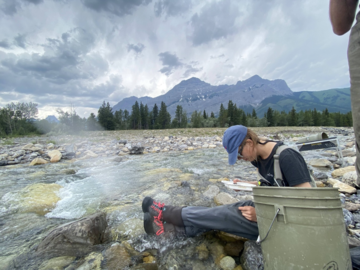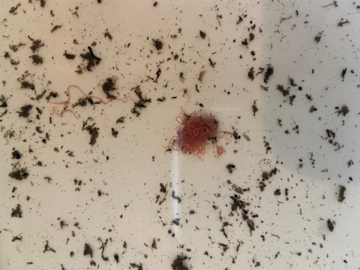Dec. 15, 2021
Notes from the field: A day and night in the life of bats, fish, and researchers in Kananaskis Country

The Barrier Lake Field Station at the Biogeoscience Institute in Kananaskis Country reopened this summer after many months of being closed to visitors and researchers. Reduced numbers, social distancing and extra cleaning and safety measures allowed researchers to stay on site safely and pursue their field research, some of which was completely put on hold last year.
Read on as we tag along with two animal-focused researchers who were based at the field station for their field work this summer.
Batty behaviour
Thiago Monteiro, a master's student in the Faculty of Science, spent the summer tracking the things that go bump in the night.
Bats are a classic villain, often associated with diseases, haunted houses and blood-sucking, but these little creatures are resilient, fascinating and essential parts of natural ecosystems.
Monteiro’s work is primarily focused on female little brown bats (Myotis lucifugus). He is working in the lab of Dr. Robert Barclay, PhD, in the biology department at the University of Calgary, and with the help of undergraduate student Trevor Thompson, is studying maternal bat colonies in the Rocky Mountains.
These colonies are large groups of female bats that come together in the spring and summer to roost and raise their pups. Just one of the three bat boxes Monteiro is monitoring had over 500 individuals at one point!
The Rockies are a harsh place for small mammals like bats, with low temperatures and unpredictable weather, even in the summer. It is a habitat that in his words “doesn’t make a lot of sense for these bats to live in,” especially considering that bats can and do migrate. Therefore, these bats must have adaptations that allow them to not only survive in this harsh environment, but also to successfully care for their pups.
As a part of his research, Monteiro sets up at dusk to capture bats using a mist net, a net with fine enough mesh that the bats cannot detect it and get gently tangled in when they attempt to fly through. After observing bats leaving the bat boxes each night, they have identified the route they typically take and can set up the net along their path.
When a bat is captured, she is checked for general health including weight, size, age, sex and, most important, reproductive condition. Some bats are fitted with transmitters to help the researchers track where bats are feeding and roosting, as well as monitor their fluctuations in body temperature.
Little Brown Bats have been recorded with a range of body temperatures stretching from 40C while flying, to below 0C while hibernating. These bats have shown an amazing ability to regulate their body temperature, something which no doubt helps them survive in their harsh rocky mountain habitat.
Guano can hold the secrets
Along with checking their health and applying transmitters, Monteiro is also interested to see if the captured bats leave any guano samples behind, because it wouldn’t really be wildlife biology if there wasn’t poop involved.
By examining the guano, researchers can gain a better understanding of where bats are getting their nutrients, something which is especially important for nursing female bats. As little brown bats are so small, their prey tends to be small to start with and then chewed and broken down into even smaller pieces. Previously, Monteiro identified insects by a leg or antennae found in the guano by microscope, but will also be sending samples to a lab for eDNA analysis this year.
The researchers have observed bats heading out to hunt in inclement weather such as rain and snow, which doesn’t line up with when their main prey, flying insects, would be out. Other studies of bats in Yukon Territory have found exciting evidence of little brown bats hunting spiders in such conditions, so Monteiro is excited for what the guano samples may reveal about the feeding habits of bats in Kananaskis Country.
Alberta fish in a whirl
Despite a somewhat whimsical name, whirling disease is not fun and games for Alberta fish species.
Whirling disease is a condition caused by multi-host parasite (Myxobolus cerebralis) which infects freshwater worms (Tubifex tubifex) and freshwater salmonid fish species. Spores from the parasite are found in water bodies, specifically in the substrate on river bottoms, where they are eaten by the bottom-dwelling worms. Inside the worm, each parasitic spore changes form into a Triactinomyxon (TAM).
These TAMs are released from the worms, float down the river and attach themselves to fish that swim nearby. Once the TAM is inside the fish, it makes its way throughout the cartilage and head and transforms again into many mature spores. After several weeks of infection, fish exhibit signs such as a blackened tail, spinal deformities, and swimming in a ‘whirling’ pattern, making them vulnerable to predation and poor at eating. Mortality rates can be as high as 90 per cent for these young fish.
The cycle begins again when infected fish die and through the decomposition process are consumed by the worms. The parasite does not infect humans so the disease poses no threat to people, but it could mean trouble for Alberta’s salmonid populations, particularly the Westslope Cutthroat trout (Oncorhynchus clarkia lewisii), which is classified as threatened. Other species that could be affected in the Bow River Basin are rainbow trout (Oncorhynchus mykiss), brook trout (Salvelinus fontinalis) and mountain whitefish (Prosopium williamsoni).
Enter Chloe Christenson, University of Alberta master's student in the fisheries and aquatic conservation lab, under the supervision of Dr. Mark Poesch, PhD, and Dr. Patrick Hanington, PhD. She spent the summer sampling water bodies, collecting data to hopefully assist in the identification of rivers or creeks with “hot spots” of whirling disease already effecting fish populations. Christenson is also identifying areas where whirling disease is not yet present but the conditions are correct for establishment of the lifecycle.
A typical field day for Christenson involves using an invertebrate kick net to collect river bottom sediment and sift through it in search of worms to collect. Small plastic trays are used to view the number of worms found, which is recorded before the worms are collected for further testing back in the lab. This initial worm count is used to compare worm densities across sites.
Water samples are also collected by passing river water through a fine mesh filter; fine enough to collect the parasites' TAM stage which is then rinsed into a collection jar. This year Christenson’s samples in the Bow River Basin, which includes 30 sites throughout the watershed, stretching from Bow Lake in the west to McKinnon Flats in the east, and High River to the south totalled 1,800 worms and 150 water samples.
Christenson has brought the samples back to the University of Alberta lab to be tested for the Myxobolus cerebralis parasite. Data collected on water temperature at each site is also key, as the development and release of the parasite is a temperature-dependent process.
Weight of evidence approach assesses risk
All of the sample types for the project are used so that varying evidence is analyzed to understand the severity of whirling disease in locations where the parasite is established. This is called a weight of evidence approach, and is also used to assess the risk for future establishment in habitat that has so far tested negative for the parasite.
The most important of these metrics is the water samples testing positive for TAMs, as it is the direct measure that the fish are being exposed to the parasite. Christenson says, “Finding the TAMs in a water sample is like finding a needle in a haystack. Because they are so small and typically only present in the water for a short period of time between hosts, if you find them in a sample it’s a good sign there is an impact on fish populations.”
Throughout the fall and winter, Christenson will analyze her samples in the lab, where data on distribution and density will help identify if there is potential for impact on fish populations in the Bow River Basin.
Once again, whirling disease is not harmful to humans, but if fish are found with symptoms you should email aep.whirl.gov.ab.ca to help in the monitoring of this potential threat to Alberta’s fish.
The Barrier Lake Field Station would like to extend a thank you to all the researchers and other visitors who allowed us to safely open our doors again in 2021.












